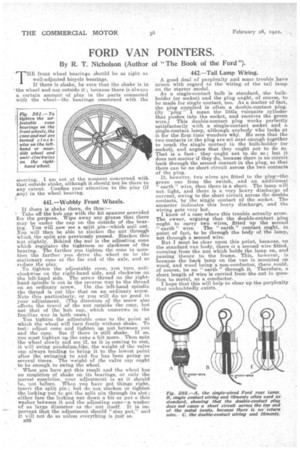FORD VAN POINTERS.
Page 26

If you've noticed an error in this article please click here to report it so we can fix it.
By R. T. Nicholson (Author of " The Book of the Ford ").
THE front wheel bearings should be as tight as well-adjusted bicycle bearings. If there is shake, be sure that the shake is in -the wheel and not outside it ; because there is always a certain amount of play in the parts connected with the wheel—the bearings concerned with the steering. I am not at the moment eoneerned with that outside shake, although it should not be there to any extent. Confine your attention to the play (if pny) in the wheel bearing.
441.—Wobbly Front Wheels.
If there is shake there, do thus:—
Take off the hub cap with the kit spanner provided Tor the purpose. Wipe away any grease that there may be under the cap on the outside of the bearing. You will now see a split pin—which pull out. You will then be able to slacken the nut through which the split pin previously passed. Slacken this nut slightly. Behind the nut is the adjusting cone which regulates the tightness or slackness of the bearing. The farther you tighten the cone in question the farther you drive the wheel on to the stationary cone at the far end of the axle, and so reduce the play. To tighten the adjustable cone, yon turn anticlockwise on the right-hand side, and clockwise on the left-hand side. The screw thread on the righthand spindle is cut in the reverse way to the thread on an ordinary screw. On the left-hand spindle the thread is cut like that on an ordinary screw. Note this particularly, or you will do no good in your adjustment. (The direction of the 'screw also affects the travel of the nut outside the cone, but not that of the hub cap, which unscrews in the familiar way in both cases.) You tighten the adjustable cone to the point at which the wheel will turn freely without shake. To test: adjust cone and tighten up nut between you and the cone. See if there is still shake. If so, you must tighten up the cone a bit more. Then spin the wheel slowly and see if, as it is coming to rest, it will swing pendulum-like, the weight of the valve cap always tending to bring it to the lowest point after the swinging to and fro has been going on several times. The weight of the valve cap ought to be enough to swing the wheel.
When you have got this result and the wheel has no suspiciorr of shake on its bearings, or only the merest suspicion, your adjustment is as it should be, not before. When you have got things right, insert the split pin ; but do not slacken or tighten the locking nut to get the split pin through its slot ; either face the locking nut down a bit or put a thin washer between it and the adjusting cone—a washee *of as large diameter as the nut itself. It is important that the adjustment should "stay put," and it will not do so unless everything is just so.
442.—Tail Lamp Wiring.
A good deal of perplexity and some trouble have arisen with regard to the wiring of the tail lamp on the starter model.
As a single-contact bulb is standard, the bulbholder (or socket) and the plug ought, of course, to be made for single contact, too. As a matter of fact, the plug eupplied is often a double-contact plug. (By plug" 1 mean the little vulcanite cylinder that pushes into the socket, and receives the green wire.) This double-contact plug works perfectly satisfactorily with a single-contact socket and a single-contact lamp, although anybody who looks at it for the first time wonders why. He sees that the two contacts in the plug are set near enough together to touch the single contact in the bulb-holder (or . socket), and argues that they ought not to do so. That is a fact: they ought not to. do so ; but it does not matter if they do, because there is no circuit back through the second contact in the plug, so that there can be no short circuit across the two contacts of the plug. If, however, two wires are fitted to the plug—the green one from the switch, and an additional
earth" wire, then there is a short. The lamp will not light, and there is a very heavy discharge. of current, owing to the short circuit across the double contacts, by the single contact of the socket. The ammeter indicates this heavy discharge, and the wiring gets very hot.
I know of a, case where this trouble actually arose. The owner, arguing that the double-contact plug ought to carry two wires, fitted up the second " earth " wire. The " earth " contact ought, in point of fact, to be through the body of the lamp, not through a second wire.
But I must be clear upon this point, because, on the standard van body, there is a second wire fitted, running, from the nut which holds the lamp on, and passing thence to the frame. This, however, is because the hack lamp on the van is mounted. on wood, and wood being a non-conductor, there could, of course, be no " earth " through it. Therefore, a short length of wire is carried from the nut in question to metal, as a conductor.
I hope that this will help to clear up the perplexity that undoubtedly exists.






























